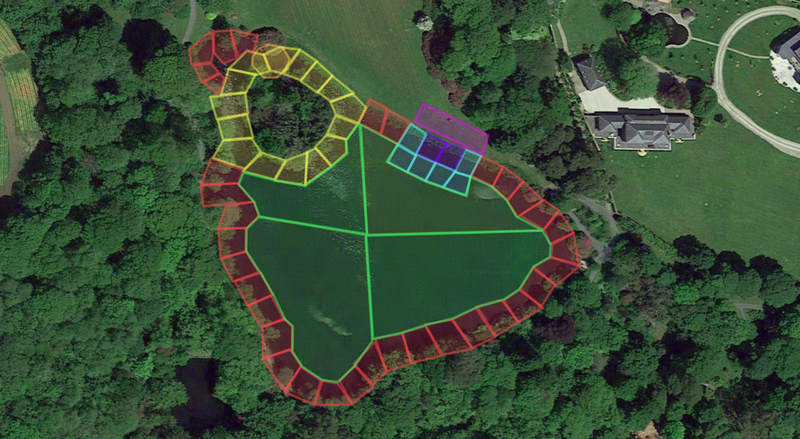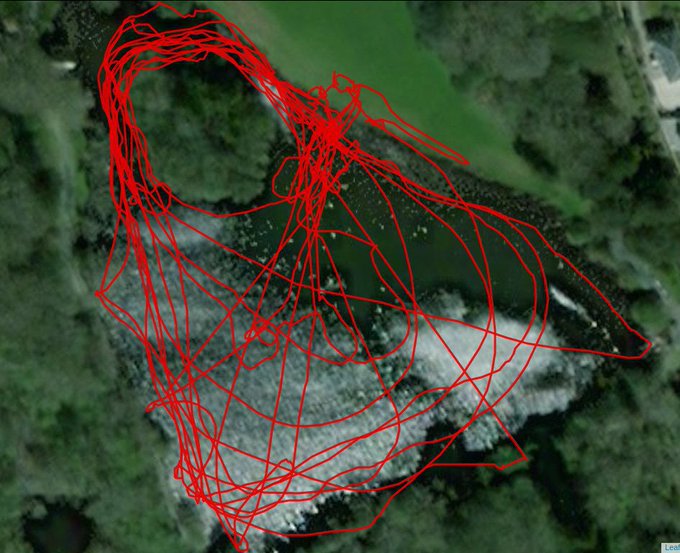Following our workshop with visually impaired people at Trevassack we were left with mixed feelings, on the one hand the participants were very happy and seemed inspired by the day - but on the other we experienced plenty of technical difficulties with the new GPS system, and didn't have enough time to really get into sonic mapping.
The important thing was that the participants gave us so much feedback and lots of insights - and luckily our partners Access Lizard Adventure had planned an event at Clowance Estate near Camborne to showcase accessible kayaking for visually impaired people, which included the Sonic Kayaks. This gave us a chance to incorporate their feedback into a full system with a couple of different sound maps.
Testing day
We knew we needed to spend some time testing on location before the event, to give ourselves a few days to make last minute tweaks. This was an opportunity to fit the sounds to the site itself - which is much more important than you might imagine, as things that work in one place are totally wrong in another. For example, previously we had worked under the assumption that we needed to keep kayak sound to a conservative minimum. This was based on the assumption that we need to reserve space for listening to what is around you in these kinds of places.
However Clowance lake is in quite an artificial surrounding - as it is part of a stately home, and the feedback we had was that our first mapping attempt was really too sparse, and that in this location, for these participants, we should fill the lake with sound. Partially this was also helped by the fact we were running two systems, so there could be a choice between a minimalist one purely for navigation purposes (first image below), and a more full on musical map with poetry and sound (second image below).


We also had a brand new tactile map of the lake made for us by Bryans Quest and Aaron Moore - the feedback from the Trevassack workshop indicated that our prototype tactile map was an important feature, so it was good to get experts to make proper ones. The maps were laser cut and made from wood and acrylic with two different sizes, the smaller version could be taken on board the kayaks for navigation out on the water.

GPS wise, we managed to finally replicate the problems we'd seen at Trevassack with the more advanced GPS system, and were able to confirm this was an electrical issue by unplugging it and reseating the crimp connections. Following the test day, we switched both systems to the older GPS so we didn't need to worry about it, and spent a bit of time with help from Kaffe, putting more sound zones in the musical map (see the revised map below). This included a great spoken recording by one of the participants from Trevassack. The older GPS systems worked fine throughout - but were indeed generally less accurate than the more problematic more advanced GPS.

The main day
On the main event day we had a steady stream of participants, and a lot of media including the BBC who were keen to interview everyone. We set up the Sonic Kayak tent and walked about testing the systems and GPS were working.

The music map was very popular, and it turned out that it was better for navigation than the minimalist one - for example you could memorise where the different poems were, as they were positioned in the four corners of the lake. This is slightly different to the navigation map, where we used sounds to warn you of specific obstacles or edges of the lake - with the music and poetry it is more about an augmentation of other senses, providing cues of where you are. This is, we think a more interesting way of working.
There were varying opinions on the artistic content itself - it was too "spooky" for some, while others liked it and found it meditative. This underlined the need to do personal maps with the participants' own choices of sounds. This would also help with the learning process involved, if a participant knew already where they had located each of their sounds in the geographic area, it would be much easier out on the water. Similarly some people preferred the tactile map for navigational support, while others wanted to only use the sound and help of the instructors to navigate, and others were keen to combine them.
Some of the kayakers naturally wanted to be on their own in a single kayak for the maximum freedom it provided. Interestingly we found that if they initially gained confidence with the lake and the sounds in the double kayak first, they could then switch to a single and use the sound coming from the double kayak (paddled by the instructors) to accurately follow and know where they were at the same time. This meant that the instructors didn't need to use their voices to do this - and it was somehow a more equal arrangement. This type of interpretation of what is useful about a system like this is a good sign that you are on to something - when people tell you what works and come up with new ideas, rather than confirming or otherwise what you imagine will work. It was amazing to have proof that the Sonic Kayaks are useful for adding confidence on the water in this way.
Technically the GPS was definitely more dependable - but more 'laggy', meaning the zones were not working quite right sometimes - so it is worth the effort tracking down a solution for the more advanced system. The next problem we encountered was Bluetooth, as (despite extensive prior testing in 'lab conditions') it tended to drop connection after an hour or two on the lake - perhaps due to distance between the Raspberry Pi and the speaker in the double kayak. Sometimes it maintained connection, but the sound became degraded and it needed to be restarted - we had not noticed this before as the GPS had required so many system restarts.
The images below are of the GPS data from the journeys that people took with the navigation system (first image) and music/poetry system (second image).


Next steps and future plans
Following the Clowance event we've made Bluetooth much more reliable by adding auto-reconnection. This is reasonably complicated as it needs to detect that the speaker is not present for whatever reason, then shut down the sound system and the Bluetooth radio (as it seems it can't reconnect otherwise) and restart everything when it comes back in range - checking every 30 seconds and repeating if it didn't work.
This has some nice side effects - as it means we can turn off the speakers to save battery when not in use (it turns out the Raspberry Pi runs for two days on a full battery, so no worries there!) and it also means that if the sound goes glitchy for some reason, the kayak instructor can restart it easily with the speaker power button in front of them rather than scrabbling around in the Raspberry Pi box in the back of the kayak.
The next step is to work with Access Lizard Adventure to help them build their own Sonic Kayak units - these will still be prototypes, but ready for them to use themselves without us around. The plan is that they will be able to create their own sonic maps for their own events and needs, which is really exciting.
This brings us to the future of the project and the kind of things we are thinking about after our summer of Sonic Kayaking with Access Lizard Adventure. We have been talking about a few possibilities:
- Open source the software and instructions for building the hardware in a way that is more useful, with a list of components and links to where to get them. Luftdaten is our current best example of this approach.
- We could sell kits consisting of all the components, at a bit above cost-price to cover our time buying them in, packing them, advertising, posting, and dealing with finances. Examples include Publiclab or Tindie.
- We could sell completed Sonic Kayak systems, as above but including the costs for the time spent building them.
- Most ambitiously, we could work with a kayak or boat builder to sell Sonic Kayaks ready to use (these could be somewhat bespoke depending on the combination of sensors people wanted, colours etc.). These would be kayaks with the speakers and sensors built in, with some waterproof controls for volume etc.
The obstacle we face with this and similar projects is that you cannot simply start selling electronics you build directly to consumers. In the US or the EU, regulation requires us to use a CE mark and Declaration of Conformity (for the EU case). This is a good explanation from the IBEX electronic product design website:
"The ‘best’ route is to submit a new product design to a notified body (a registered company that provides compliance testing) to ensure that you are fully complaint. Alternatively you may decide that the cost of this is too high for a particular product, or the risk of non-compliance is low, and instead self certify the product.
To give you an idea of the costs involved, to use the BSI to provide CE marking services for a relatively typical electronic product (Low Voltage Directive and EMC compliance) would be likely to cost in the region of £8,000 to £10,000. Bear in mind this just a rough estimate and costs will vary, sometimes significantly, based on specifics of your product. Of this between £1,000 and £1,500 would typically be the cost to carry out the paperwork side of the work with the remainder being the costs to carry out the lab based testing.
For products that are battery powered the testing requirements are often reduced, especially if the product is targeted at industrial rather than consumer use. A typical battery powered product will not require LVD electrical safety testing, reducing the requirement to just EMC testing for immunity (to interference) and emissions. This can reduce the lab testing cost to around £1500 if the product passes first time and if the products application allows it to be tested to generic industrial standards
If your product included wireless communications (e.g. bluetooth, DECT, WiFi etc) then it needs to comply with the Radio and Telecommunications Directive which can add a significant cost."
We're not particularly interested in making lots of items to sell (and selling people things they might not need doesn't fit well with our general ethos or with the climate crisis) - which makes the time and expense of going through these processes even more off-putting. If we had a change of heart and did decide to do this, the best approach would probably be to partner with an organisation that manufactures and sells electronics kits already (as Boldport have recently done with Pimoroni)
Some more realistic approaches for for us to consider could be:
- Following a more service based approach that we are very familiar with - for example focusing on running events with Sonic Kayaks.
- Continuing our current approach of open sourcing the design and software and focusing our energy on making it easier for others to build their own.
- Following a new research and development route - for example a new collaborative project to design a kayak with the kit inbuilt.
These all fit a little better with our existing knowledge and interests, and allow us to further develop the Sonic Kayaks as an artistic experience and citizen science project.


